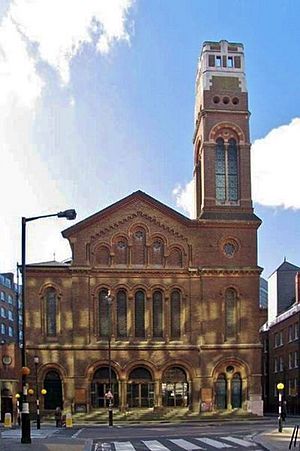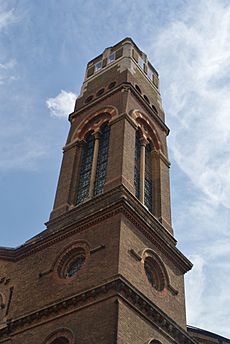Westminster Chapel facts for kids
Quick facts for kids Westminster Chapel |
|
|---|---|

The front of Westminster Chapel
seen from Petty France |
|
| OS grid reference | TQ 29329 79407 |
| Location | Westminster |
| Country | England |
| Denomination | Evangelical free church, affiliated to EFCC, FIEC & Newfrontiers |
| Previous denomination | Congregational Union |
| Tradition | Congregational |
| Membership | 250 |
| History | |
| Founded | 1840 |
| Founder(s) | Samuel Martin |
| Architecture | |
| Heritage designation | Grade II |
| Architect(s) | William Ford Poulton |
| Style | Lombard Romanesque Revival |
| Years built | 1864–65 |
| Completed | 1865 |
| Specifications | |
| Capacity | 1,500 |
Westminster Chapel is a special kind of Christian church in central London. It is located in Westminster, on Buckingham Gate. This street is close to Victoria Street and not far from Buckingham Palace.
Over the years, many important pastors have led the church. Some of these include Samuel Martin, G. Campbell Morgan, John Henry Jowett, Martyn Lloyd-Jones, and R. T. Kendall.
Contents
History of Westminster Chapel
The church community of Westminster Chapel started in 1840. Their first building was finished in 1841 on Buckingham Gate. The church quickly grew and needed a bigger space.
So, a new, larger chapel was built from 1864 to 1865. This is the building you see today! It opened on July 6, 1865. The new chapel could originally seat about 1,500 people. Today, it can hold around 1,000 people.
Past Leaders of the Chapel
Westminster Chapel has been led by several well-known pastors. These include Samuel Martin (1842–1878), G. Campbell Morgan (who served twice, 1904–1917 and 1933–1943), John Henry Jowett (1918–1922), Martyn Lloyd-Jones (1939–1968), and R. T. Kendall (1977–2002). Greg Haslam was also a pastor from 2002 to 2016.
The chapel began as a Congregational church. However, during the time of Pastor D. Martyn Lloyd-Jones, the church decided to become independent. It joined groups like the Evangelical Fellowship of Congregational Churches and the Fellowship of Independent Evangelical Churches.
Important leaders, called deacons, have also served at Westminster Chapel. One famous deacon was Sir Fred Catherwood.
The chapel has also hosted many Christian meetings and conferences over the years.
What Happens at Westminster Chapel
Sunday Services
Westminster Chapel is an evangelical church. This means they believe strongly in the Bible. Their Sunday services include worship (singing and prayer) and a sermon based on the Bible. Sometimes, people also share messages they believe are from God.
The church wants to share its message with London, the UK, and other countries. They aim to be a church led by the Holy Spirit and focused on helping others. Sunday services start at 11 am.
Life Groups and Community
Smaller groups, called Life Groups, meet in homes around London. These groups usually gather on Tuesday and Wednesday evenings. There are also special groups just for students. The church says these groups are important for making friends, learning more about faith, and sharing their beliefs.
Alpha Course
Westminster Chapel offers a free Alpha course twice a year. This course is a chance for people to explore big questions about life and faith. It usually includes dinner and discussions on Monday nights.
Westminster Foodbank
The chapel helps run the Westminster Foodbank. This food bank is part of the Trussell Trust network. It provides food to people in need in the local community.
Support for Students
Many students and young adults (in their twenties) attend Westminster Chapel. The church has a special team dedicated to supporting this age group. They organize events just for students and young adults, as well as larger church events they can join.
Twice a year, the chapel also holds a special retreat for students and young adults.
Pastors of Westminster Chapel
In August 2016, the church announced that a team of elders would lead the church. Howard Satterthwaite was appointed as the Lead Elder.
Here is a list of the pastors who have served at Westminster Chapel:
- 1842–1878 Revd Samuel Martin
- 1876–1887 Revd Henry Simon
- 1894–1895 Revd W. Evans Hurndall
- 1896–1902 Revd Richard Westrope
- 1904–1917 Revd G. Campbell Morgan
- 1904–1907 Revd Albert Swift (co-pastor)
- 1918–1922 Revd John Henry Jowett
- 1923–1925 Revd John Hutton
- 1928–1933 Revd Hubert Simpson
- 1933–1943 Revd G. Campbell Morgan (associate minister)
- 1939–1968 Revd D. Martyn Lloyd-Jones (associate minister until 1943)
- 1969–1974 Revd J. Glyn Owen
- 1977–2002 Revd R. T. Kendall
- 2002–2016 Revd Greg Haslam
- 2016–2023 Revd Howard Satterthwaite
Architecture of the Chapel
The current chapel building was finished in 1865. It was designed by an architect named William Ford Poulton. He used a style called Lombard Romanesque Revival. This style often uses round arches and brickwork.
The chapel is built with light-colored bricks and some red bricks and stone. The front of the building has a special entrance with three arches. There is also a tower on the right side. The very top part of the tower was added later in the 20th century.
Inside, the main area where people sit is almost oval-shaped. It has two levels of balconies. There is a high platform at the front for the Communion Table and chairs. Even higher is a very large circular platform, which is the pulpit where the minister preaches. It might be one of the biggest pulpits in any church!
Westminster Chapel is a Grade II Listed building. This means it is an important historical building that is protected.
Pipe Organ
The chapel has a large pipe organ with four keyboards. It was built by a famous organ-builder named Henry Willis. Later, in the 1920s, it was repaired and made even bigger.



